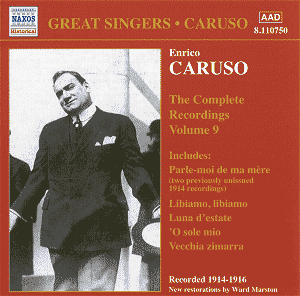Hugh Griffith’s informative
sleeve note points out that although
Caruso did not know it, 1914 was a defining
year in Europe as far as his career
was concerned. On June 29th
he sang Cavaradossi at Covent Garden
in what was to be his last appearance
there. This was one day after the assassination
of Francois Ferdinand, heir apparent
to the dual monarchy of Austria-Hungary
which lit the fuse for World War 1.
There would be no more appearances in
Germany or Austria either, and when
Italy entered the war the following
year, no journeys home until after the
Armistice was signed. However, the singer’s
career was largely centred around the
‘Met’. He substituted a punishing schedule
in South America, involving 52 appearances
in 102 days, and without the benefit
of the enforced rest that the boat journey
to Europe entailed.
By this stage of his
career, Caruso had already recorded
almost all the big operatic numbers
that suited his voice. His record company,
Victor, generally only repeated the
likes of the Rigoletto quartet or Lucia
sextet matching the latest soprano star
with their tenor. This disc fills in
two Caruso gaps, the ‘Brindisi’ from
Verdi’s La Traviata, and the ‘Ingemisco’
from his Requiem. In the former Caruso
lightens his tone most effectively,
whilst Alma Gluck isn’t a typical or
pleasant Gilda (tr. 1), but in the latter
his tone is too heavy, even lugubrious,
when he needs to float some head voice
(tr. 9). Certainly in Donizetti’s charming
‘Angelo casto e bel’, recorded the same
day, Jan 15th 1915, finds
him with lighter tone and fine legato
(tr. 10). Of the Carmen Act 1 duet,
with Frances Alda a heavy Micaela, the
booklet shows tr. 4 as an alternate
take ‘never previously issued’, and
the repeat on tr. 5 as un-issued on
78rpm. Certainly the great tenor is
comfortable and idiomatic in French
with good mid voice support and graceful
phrasing. Elsewhere the disc comprises
songs and arias by composers active
in Naples in the decades before World
War 1. In that milieu Caruso was king
among mortals. There are also arias
from generally long forgotten works.
A significant exception is ‘Vecchia
zimarra’, Colline’s farewell to his
coat from La Boheme, an aria for the
bass voice! (tr. 20). This was never
intended for public sale, a few copies
being distributed to Caruso’s friends
as a memento of a feat he had performed,
on stage in Philadelphia, when the bass
had a throat infection. By Act 4, the
bass’s voice was completely gone and
Caruso had sung the aria for him and
without the audience being aware - amazing.
The re-mastering is
up to the usual high standard of this
series, although I found an added clarity
in the following volume (10), reviewed
elsewhere on this site, perhaps because
of access to masters. Those following
this excellent series should not hesitate,
not least for the rarity of many of
the items included.
Robert J Farr
 Enrico
CARUSO (tenor). 1873-1921
Enrico
CARUSO (tenor). 1873-1921